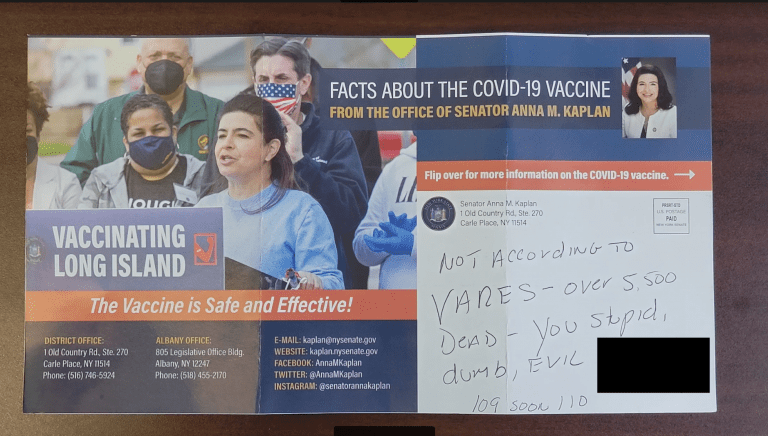
Antisemitic attacks throughout Long Island have increased by 23% last year, with 32 incidents reported throughout Nassau County, according to statistics provided by the Anti-Defamation League.
The local increase of antisemitic incidents reflects a larger statewide trend. A total of 416 antisemitic incidents were reported throughout New York in 2021, a 24% increase from 2020, according to statistics.
Scott Richman, regional director for the Anti-Defamation League New York/New Jersey, said the rise in antisemitic instances should be a cause of concern for everyone, not just those within the Jewish community.
“The fact that these incidents included an unprecedented number of vicious assaults – frequently targeting visibly Jewish individuals on the streets of New York, including young children, is incredibly disturbing,” Richman said in a statement. “The message that this data is sending us is clear: antisemitism, like other forms of hate, is not going away, and we must proactively work together to protect our community by combating antisemitic statements and behavior before they lead to even more violence.”
Statistics showed New York’s rise in antisemitic incidents last year accounted for 15% of such incidents throughout the entire country in 2021. New York’s statistics were comprised of 183 harassment incidents, 182 vandalism incidents and 161 incidents involving swastikas.
Jonathan Greenblatt, CEO of the Anti-Defamation League, told MSNBC that the data is “very damning” and that the record number of incidents tracked by the organization last year was “shocking.”
“We’re in this moment where offenses across the board are on the rise,” Greenblatt said. “We saw 167% increase in antisemitic assaults in 2021…Make no mistake that neither [political] party has a monopoly on morality.”
Greenblatt, whose wife is an Iranian refugee with deep roots to her home country, previously said some Americans could face the fate of his wife and his grandfather, a Jew from Germany, and be forced to leave the nation if these acts of hatred are not properly combated during an interview with Blank Slate Media.
Greenblatt said he does not believe it to be far-fetched that future family members may have the same fate of his wife and grandfather if antisemitic trends continue to rise.
“I don’t think it’s unthinkable for me as a Jew to imagine that one day my grandchildren might not be born here,” he said. “This country, the only one that I’ve ever known and loved, could one day change so dramatically that it forces me and my family to flee.”
The ADL, Greenblatt said, has been tracking antisemitic trends and instances for roughly 60 years, with antisemitic attitudes being held now by 8 to 10% of the American population. Despite the fact that millions of people still have those mindsets, he said, the statistics provide some encouragement though more work needs to be done.
The North Shore has seen a fair share of antisemitic and anti-Asian instances and subsequent demonstrations condemning those actions over the past two years, including a hijacking of a torah study event held via Zoom, vandalism on a local high school’s website and swastikas spray-painted on the outer walls of various structures.
In October, Great Neck North High School held a forum organized by community leaders Lori Beth Schwartz and Judy Liman which discussed ways to combat antisemitism through education.
State Sen. Anna Kaplan (D-North Hills) also promoted legislation for the state Senate to conduct a study on courses of study on the Holocaust in New York’s schools in April.
Kaplan said that a recent study by the nonprofit Conference on Jewish Material Claims Against Germany revealed that 58% of New Yorkers aged 18 to 39 cannot name a single concentration camp, that 19% believe that Jews caused the Holocaust and that 28% believe the Holocaust is a myth or has been exaggerated. In each of these three metrics, New York had the worst score of any state in the country.
Kaplan said the statistics were “deeply disturbing” but something that did not surprise her.
“We need to stop this cycle,” Kaplan said. “And I think education is one of the key factors how we could do this.”






